Harnessing the power of the sun, solar overhang roof ideas leverage sustainable energy sources to provide eco-friendly and cost-effective solutions for modern homes.
Harnessing the sun’s energy through solar panels can be a smart and sustainable way to power your home. When considering installation, an often overlooked aspect is the use of solar overhangs or solar awnings. These structures, attached to the side of a building, can capture sunlight for energy while providing shade and reducing heat intake.
In this article, we will delve into a variety of solar overhang roof ideas, exploring their benefits, design options, and installation process. Whether you’re looking for a way to cut down on energy costs or wanting to make a greener choice for the environment, this comprehensive guide can assist you in understanding and implementing solar overhangs in your home.
Solar Photovoltaic (PV) Panel Integrated Roofs

Solar Photovoltaic (PV) Panel Integrated Roofs seamlessly merge with your home’s architecture, improving aesthetics without compromising performance. This advanced design is not only built to harness the sun’s power but also to withstand harsh weather conditions.
Key Points:
- Integration: PV panels are constructed as part of the roofing material, offering a sleek, unobtrusive look.
- Energy Efficiency: These PV panels convert sunlight directly into electricity, reducing reliance on grid power.
- Weather Resistance: These roofs are built to withstand harsh weather conditions, enhancing the lifespan of your home’s roof.
- Cost-Effectiveness: Generates savings in the utility bills over time, offsetting the initial installation cost.
- Environmental Impact: Producing renewable energy, these roofs significantly reduce your carbon footprint.
The effective use of Solar Photovoltaic (PV) Panel Integrated Roofs ensures a balance between aesthetics, energy efficiency, and environmental sustainability. It marks a radical shift from conventional roofing, bringing you a step closer to a green and sustainable future.
Tilted Solar Angle Overhangs
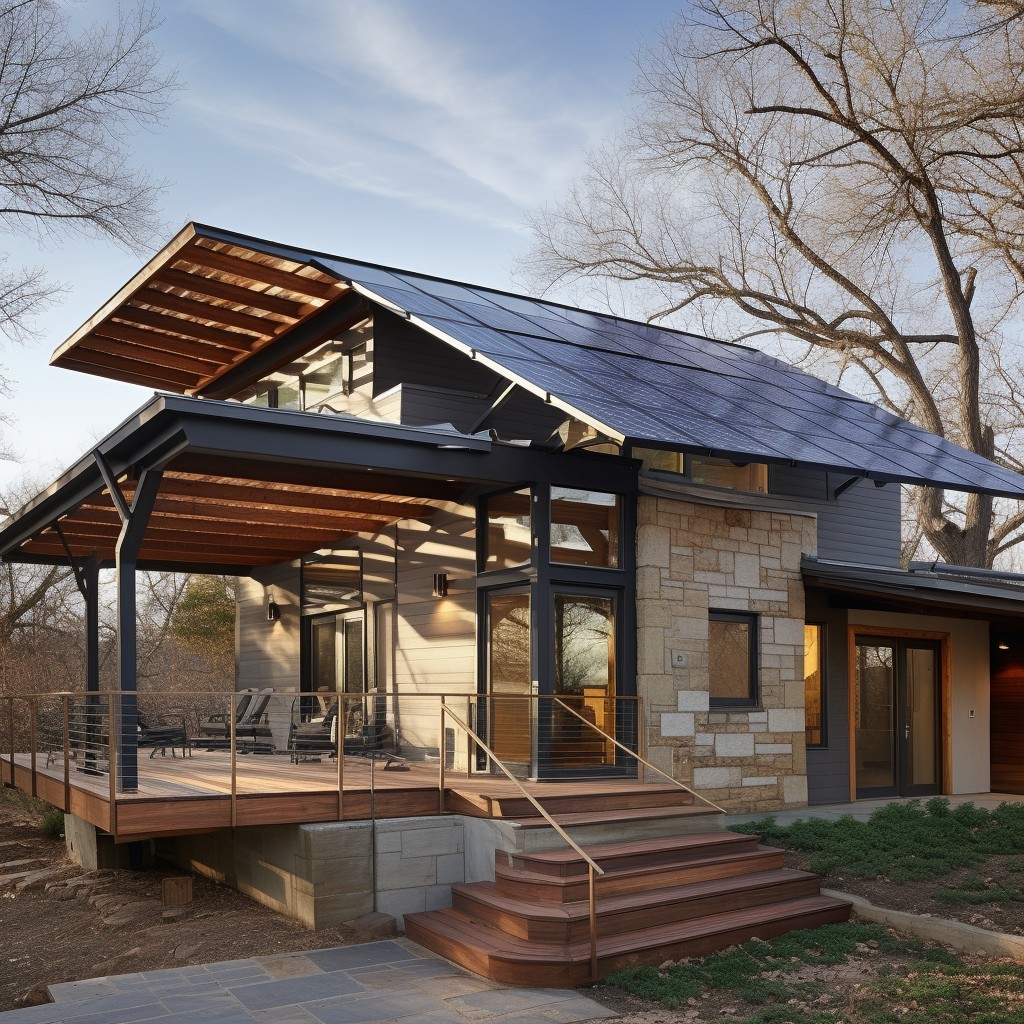
Ideal angles for these overhangs depend significantly on the geographic location. In general, they should align with a latitude’s angle to harness maximum sunlight throughout the year. Precision plays an essential role in ensuring the highest sunlight exposure to accomplish energy efficiency.
Key points on Tilted Solar Angle Overhangs concepts:
- Optimal angle choice: The inclination of these overhangs should match the area’s latitudinal angle for effective sunlight absorption.
- Seasonal changes: Understanding that the sun’s height varies with seasons, one can manually adjust the tilt or have it automated.
- Design considerations: Balancing shade provision for windows and optimizing power generation through angle adjustments is vital.
- Maximum efficiency: By tilting at specific angles, the solar panels absorb the maximum possible sunlight. It maximizes their power generation capacity and, in turn, overall system efficiency.
Solar Thermal Collector Roofs

Harnessing the power of the sun, Solar Thermal Collector Roofs are designed to convert solar radiation into heat, which can then be used for various domestic and commercial applications. Key concepts behind this highly efficient form of solar energy utilization include:
- 1. Absorption: The panel’s dark surface absorbs solar radiation effectively, converting light into thermal energy.
- 2. Heat Transfer: Heat is transferred from the panel to a heat-transporting fluid, typically a mixture of water and antifreeze.
- 3. Storage: The heated fluid is stored in a well-insulated tank until it is needed for heating or hot water supply.
- 4. Control: Technology is used to manage the system’s operation, ensuring optimal functionality and minimal energy waste.
These principles aid in understanding the practicality and efficiency of Solar Thermal Collector Roofs, offering a sustainable way to meet thermal energy demands.
Flat Overhangs With Solar Shed Designs

Capitalizing on the expanse of flat roofs, solar sheds innovatively combine form and function. An illustration of an all-in-one design, they merge energy efficiency and practical storage.
Key points include:
- 1. Optimal Utilization of Space: Ideal for homes with limited backyard space, this design enables dual utility – energy creation and storage solution.
- 2. Grid-Tied Systems: Mostly connected to the power grid, these setups have the capability to sell excess electricity back, potentially reducing energy costs.
- 3. Easy Maintenance: Flat overhangs offer convenient access for cleaning and maintenance of solar panels.
- 4. Customizable Size: The extendable nature of solar sheds allows for expansion in line with the increased power needs.
- 5. Building Regulations: The design must comply with local building codes pertaining to load-bearing capacity, fire safety, and other requirements.
The smart synthesis of functionality and sustainability in one package makes solar sheds a valuable addition to urban residences.
Eco-Friendly Greenhouse Overhangs

Capable of both harnessing sunlight and providing a controlled environment for plant growth, this unique design offers multi-faceted benefits. Two of the main components are:
1. Effective Utilization of Sunlight: The greenhouse uses translucent overhangs with solar panels that absorb energy while allowing enough light through for plants underneath to thrive.
2. Temperature Regulation: Solar greenhouse overhangs enhance climate control, moderating temperature swings. This feature proves useful in keeping the interior climate stable, crucial for maximizing plant growth.
These eco-friendly greenhouse constructs prove to be much more than just protective canopies, they serve as models for sustainable energy generation and ecosystem conservation.
Solar Cell Modular Overhang System
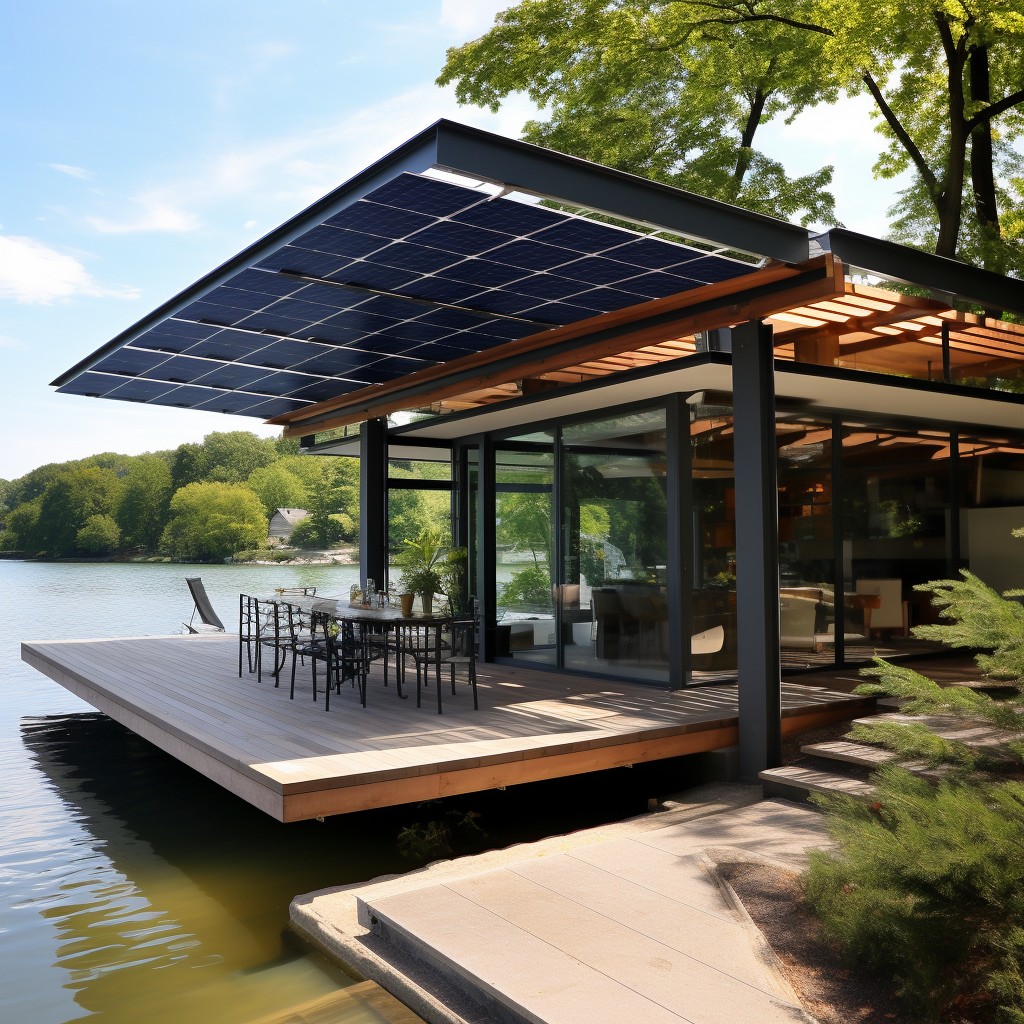
This unique system involves connecting individual solar cells, encapsulated into modules, thereby allowing flexibility in the configuration and installation.
Key points:
- Customizable: The modular nature gives this system a distinct advantage in customization to specific sizes and shapes.
- Expandable: As the demand for energy increases, additional modules can be easily added.
- Versatility: Suitable for both existing structures and new constructions, incorporating cells directly onto roof overhangs.
- Efficiency: This system ensures maximum sun exposure for each cell, leading to higher energy production.
- Easy Maintenance: Damaged modules can be replaced without affecting the entire system.
- Cost-effective: Initial setup cost is low with the opportunity for future expansion.
Thus, Solar Cell Modular Overhang System provides a flexible, efficient, and economic solution for harnessing solar power.
Solar-Reflective Roof Overhang
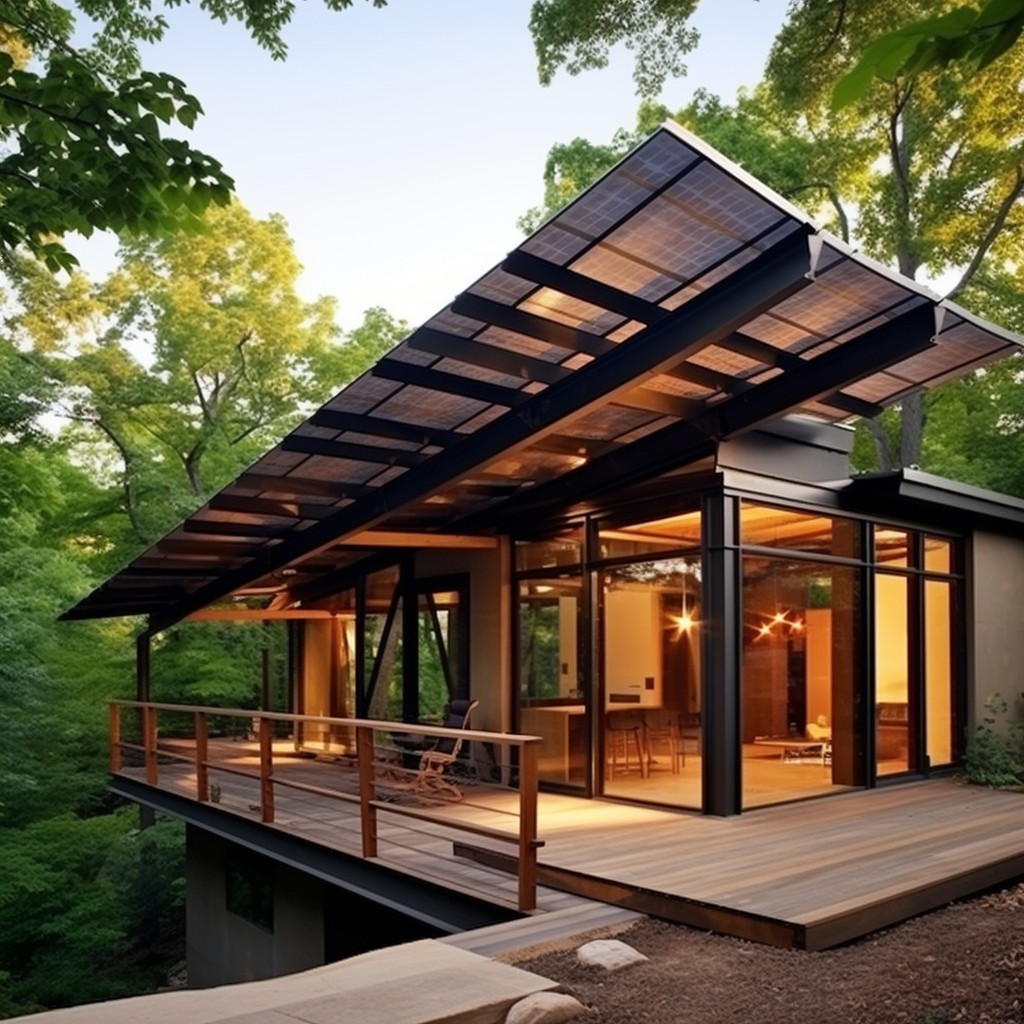
In maximizing solar energy efficiency, solar-reflective roof overhangs play a crucial role. They keep the under space cool during summer and prevent unwanted heat gain in winter. The concept is steeped in the principles of light absorption, reflectance, and emissivity – the three primary aspects that govern solar-reflective surfaces.
Key Points:
- Reflectance: This concerns the capacity of the roof overhang to reflect solar radiation, thereby reducing the absorbed heat.
- Emissivity: It implies the ability of the surface to emit absorbed heat. High emissivity contributes to superior temperature regulation.
- Angle: The angle of the overhang plays a pivotal role in managing seasonal sunlight variations. Optimizing this angle enhances energy efficiency.
- Material: Using certain materials, such as ‘cool’ colored metals, increases solar reflectivity, boosting the performance of the overhang.
- Coating: Specialized reflective paint or coating can significantly enhance a surface’s solar reflectance.
By paying attention to these factors, solar-reflective overhangs can effectively leverage power conservation while augmenting the structural aesthetic.
Multi-Tiered Solar Layering
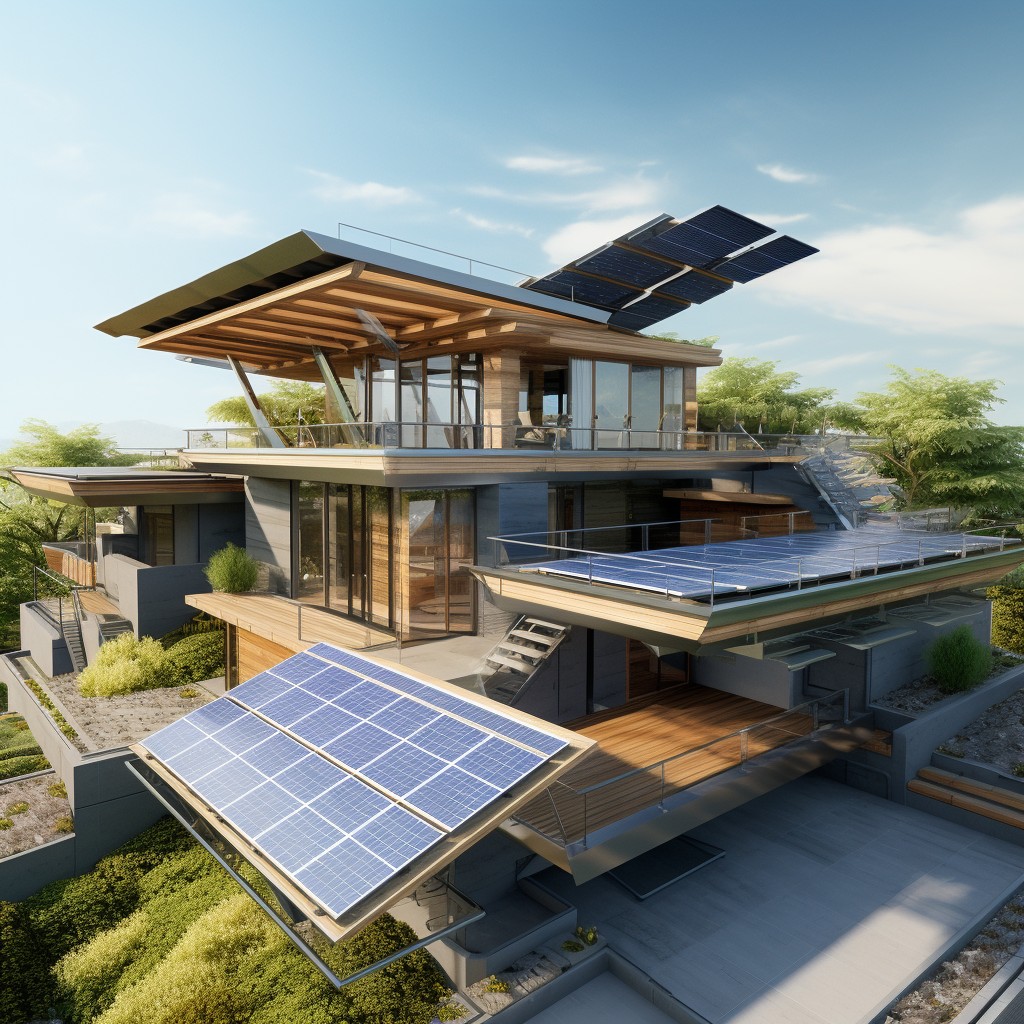
Multi-tiered solar layering involves installing solar PV panels on various levels or tiers of a roof. It’s a ground-breaking design technique aimed at maximizing solar energy collection in properties with limited roof space or in areas with diverse sun exposure. This design also offers an aesthetic appeal, adding a modern eclectic charm to the building.
Key points:
- Space Efficiency: The multi-tiered structure optimally uses limited roof space, allowing more panels to be installed.
- Diverse Sun Exposure: This layout can capture sunlight throughout the day as different levels receive light at divergent times.
- Increased Energy Production: Multiple tiers of solar panels increase the overall production of renewable energy, reducing utility bills and carbon footprints.
- Design Aesthetics: They offer a fusion of functionality and design, introducing a modern edge to the building look.
Though installation might be initially complicated, the long-term benefits are substantial, potentially revolutionizing the way we harness solar energy.
Modernistic Solar Overhangs

Uniquely designed for aesthetics and utility, Modernistic Solar Overhangs present an astounding fusion of art and technology. Such installations typically feature sleek lines, clean geometrical patterns, and a sophisticated look that suits contemporary architecture. Their functionality is not compromised for style, as these overhangs adeptly harness the power of the sun, thereby offering an efficient, renewable energy solution for residential and commercial spaces.
Key Features of Modernistic Solar Overhangs:
- Minimalistic Design: Incorporated with understated yet chic geometry complementing modern architectural aesthetics.
- High Efficiency: Equipped with cutting-edge photovoltaic cells, converting solar energy into electricity with unparalleled efficiency.
- Easy Integration: Can be seamlessly integrated with existing structures, offering an undisturbed, streamlined look.
- Sustainable: Provides a green energy solution, reducing reliance on fossil fuels and decreasing carbon footprint.
- Innovative: With advancements in technology, come equipped with features like solar tracking for enhanced energy output.
- Durable: Constructed with materials that withstand weather elements, ensuring longevity.
Through combining form and function, modernistic solar overhangs thus shape the future of sustainable architecture and energy-efficient homes.
Translucent Solar Canopy Designs

Translucent solar canopies offer an innovative adaptation of conventional roof overhangs. These designs elegantly merge the need for shade and aesthetic appeal with energy generation.
Key points to understand this concept:
- Translucent Photovoltaic Cells: They transform sunlight into electrical power, while permitting some light to filter through for a bright, naturally illuminated space.
- Versatility: These canopies are flexible in their architectural design, allowing a multitude of adaptation possibilities including patios, storefronts and even carports.
- Eco-friendly: The integration of solar power enhances the environmental profile of the building, reducing reliance on traditional energy sources.
- Reduced Energy Costs: By generating their own electricity, these overhangs contribute to substantial energy cost savings.
- Aesthetic appeal: Beyond functionality, translucent solar canopies add a sophisticated, modern appeal to any structure.
Hence, the combination of sustainability, energy efficiency, and design makes translucent solar canopy designs an attractive option for contemporary architecture.
Adaptive Solar Panel Tracks

Harnessing maximum power from the sun effectively necessitates adaptive solar panel tracks. This technology revolves around the concept of ‘solar tracking’, allowing panels to follow the sun’s path during the day, thereby optimizing the exposure to sunlight.
Key characteristics of adaptive solar panel tracks include:
- Panel Movement: Panel tracks are designed to move either in a single axis (east to west) or dual-axis (also accounting for seasonal changes in the sun’s position).
- Increased Efficiency: Tracking systems significantly improve energy output by up to 25-45%, compared to stationary setups.
- Cost: Installation and maintenance expenses can be higher than fixed-tilt systems, but the increased energy yield often offsets these costs.
- Bespoke Orientation: Solar trackers are adapted not just for the geographic location, but also for specific site conditions – from ground slope to shade patterns.
This innovative system employs smart sensors and motors to rotate the panels, becoming a valuable addition to optimize solar energy extraction.
Retractable Solar Panel Systems

Retractable solar panel systems prove instrumental in harnessing optimal levels of sunlight throughout the day. This advanced solar solution provides flexibility, operational convenience, and increased energy efficiency.
Important to note are three overarching features of retractable solar panel systems:
- Dynamic Positioning: The key differentiator of these systems, these panels can mechanically retract or extend to get the best exposure to the sun. This results in capturing more solar energy compared to fixed installations.
- Weather Resilience: Their ability to retract confers an added advantage of protection against harsh weather conditions.
- Space Efficiency: Retractable systems offer a space-saving solution for roofs with limited area.
The utilisation of innovative technology and smart design in retractable solar panel systems shows the evolution of solar power and its endless possibilities.
Vintage Solar Overhangs With Historical Motifs

Rooted in past architectural designs, vintage solar overhangs apply aesthetic charms of bygone eras amidst the harmony of cutting-edge technology. Equally key, these structures play a pivotal role in optimizing the harnessing of sun rays. Employing a blend of craftsmanship, extravagant designs, and eco-friendliness, they emulate historic motifs elegantly, bringing a sense of nostalgia.
Key Aspects:
- Exquisite: The respect for antiquated motifs and patterns results in an elegantly stunning visual appeal. Such richness in detail sets these solar overhangs apart from their modern counterparts.
- Compatibility: The historic designs blend seamlessly with vintage-style homes, ensuring aesthetic consistency.
- Efficiency: Despite the vintage aesthetics, these overhangs take full advantage of modern solar panel efficiency.
- Customizable: Designs can mirror various periods, like Victorian or Greek revival, to match the surrounding architecture.
In marrying the past and future, vintage solar overhangs provide functional, unique solutions that capture and utilize sunlight in a setting replete with historical resonance.
Minimalistic Solar Awning Design

Harnessing the power of the sun while maintaining a clean, uncluttered aesthetic, this method is a favorite amongst admirers of modern design. It involves incorporating thin, sleek solar panels onto the structure of the awning.
Key points include:
- Material: Lightweight, thin but durable materials such as monocrystalline or thin-film solar panels are used, often in black or dark tones, for a sleek look.
- Functionality: Despite their sleek design, these panels are fully operational and capable of producing a significant amount of power, enough to run small appliances or light fixtures attached to the awning.
- Flexibility: The design is adaptable and can be modified to fit a variety of outdoor spaces. The aim is to optimize sun exposure without compromising the overall aesthetic.
- Integration: This design integrates seamlessly into the structure, almost appearing as part of the original architectural plan, offering a sleek alternative to more traditional, bulky solar installations.
- Efficiency: The panels, despite their minimalist design, are highly efficient and make the most of available sunlight. This ensures you’re making the most out of your solar investment.
- Ease of installation: Due to their lightweight structure, these awnings are simpler and quicker to install than traditional solar set-ups.
In essence, this design offers the best of both worlds, combining efficient solar power capture with an aesthetically pleasing form.
Solar-Powered Pergola Overhang

Harnessing the elegance of a traditional pergola with the energy efficiency of photovoltaics, this style of overhang serves dual functions. It offers shade, creating a cool outdoor area while simultaneously generating electricity. The structure integrates solar panels into its design, replacing standard pergola roofing with fully functional photovoltaic panels.
Key points to consider:
- Aesthetics: These structures blend seamlessly with the surrounding architecture, maintaining the aesthetics of a traditional pergola.
- Energy Efficiency: The incorporated solar panels ensure effective solar energy conversion, thereby reducing reliance on other energy sources.
- Space Utilization: In addition to being an electricity generator, it serves as a beautiful, functional outdoor living space.
- Dual Functionality: Besides offering shade and protection from elements, it contributes to energy savings by producing renewable electricity for your home or business.
- Environmentally Friendly: This eco-friendly solution effectively reduces the carbon footprint, promoting sustainable lifestyle practices.
Glass Solar Roofs With Adjustable Tilt

This innovative design optimizes sunlight capture through repositionable panels. The utility and aesthetics of glass solar roofs are boosted by their flexibility. They have a pivoting mechanism allowing the tilt of the panels to be adjusted according to the sun’s movements.
Key Points:
- 1. Enhances solar efficiency: By modifying the incline, these roofs can absorb more solar energy, boosting productivity.
- 2. Flexibility: The capacity to adjust the tilt provides an adaptable response to varying sun angles throughout the day and during different seasons.
- 3. Aesthetics: In addition to their functionality, these state-of-the-art panels blur the line between architecture and technology.
- 4. Cost-effective integration: Combining roof installation with energy production minimizes the additional infrastructure required.
- 5. Eco-friendly: Maximised energy capture lessens dependence on non-renewable sources, aiding in carbon footprint reduction.
Thus, glass solar roofs with adjustable tilts play a crucial role in sustainable energy production, marrying scientific innovation with everyday usability.
Solar Energy Harvesting Louvre Roofs

Solar energy harvesting louvre roofs are an innovative design approach focused on efficiency and aesthetics. They utilize adjustable louvres that can be controlled to optimize the collection of solar energy throughout the day. These type of solar overhangs have the following key features:
- Adjustable Panels: The louvres orient automatically based on the position of the sun, maximizing energy extraction.
- Architectural Integration: The sleek design adapts to any architectural style, enhancing the aesthetic value of the building.
- Energy Efficiency: By continually adjusting to the sun’s position, these roofs produce efficient energy yield.
- Temperature and Light Control: Besides energy harvest, the louvre offers sun protection, managing interior light and temperature.
- Additional Functionality: Some designs integrate other sustainable technologies, like rainwater collection systems or natural ventilation mechanisms.
Thus, these factors show how solar energy harvesting louvre roofs are revolutionizing sustainable architectural design.
Artistic Solar Overhang Installation

Creativity and functionality can merge seamlessly in the realm of Artistic Solar Overhang Installation. This ingenious approach combines the generation of renewable energy with thought-provoking designs.
Key Points:
- Design-driven: Unlike standard installations, these overhangs embrace aesthetics, taking the form of assorted figures, abstract elements, or architectural motifs.
- Space Utility: While primarily an art, these installations also ensure optimal use of the overhang space for solar energy production.
- Sunlight harvesting: Designed to capture sunlight judiciously, they don’t compromise on their duty as solar absorbents.
- Customizable: Highly adaptable, they offer customization options to reflect property aesthetics or personal preferences.
- Dual benefits: Besides energy generation, they contribute positively to the property’s curb appeal.
In essence, these art-infused installations successfully bring a striking aesthetic element to solar power systems, showing that renewable energy can also be visually appealing.
Multifunctional Solar Overhangs With LED Lights

These constructions leverage the dual functionality of providing shade and generating power. By integrating LED lights into the design, they serve more than daytime utility. The embedded lights, powered by the harnessed solar energy, provide eco-friendly illumination during the darker hours of the day.
Key Points:
- Dual function: Besides serving as a shade, they harness solar energy.
- LED lights: Energy-efficient lighting option; utilizing the stored solar energy from daylight hours.
- Zero-energy: The solar panels cover the energy consumption, resulting in an energy-neutral operation.
- Green initiative: This design lowers carbon footprint by reducing reliance on traditional electricity sources.
- Design versatility: They can be customized to complement various architectural aesthetics.
- Cost-effective: Despite a moderately higher initial investment, the long-term returns are profitable due to lower utility bills.
Solar Overhangs Integrated With Rainwater Collection System
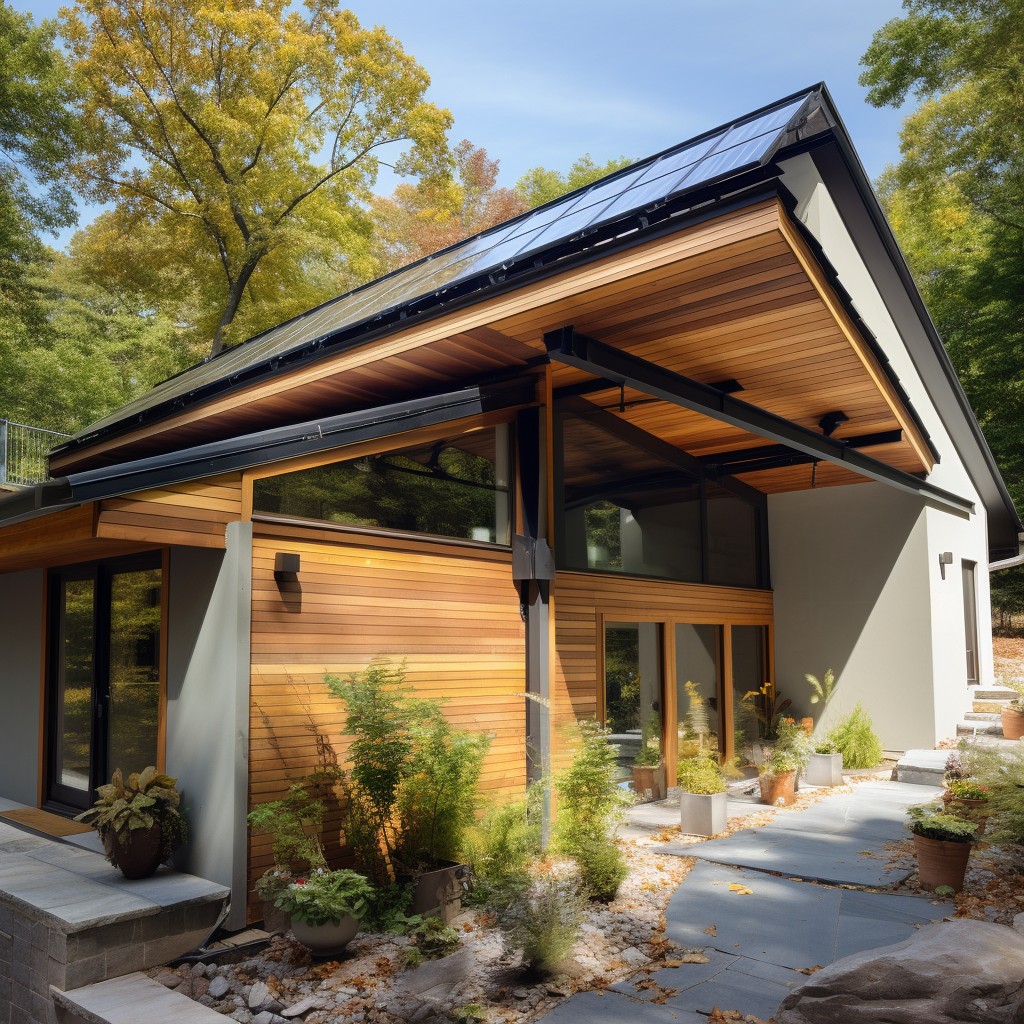
This dual-function design ensures maximum utility from your roof overhang, combining energy generation and water conservation awareness into one eco-friendly structure. Apart from harnessing sunlight to generate green power, this system collects and stores rainwater for various household uses.
Key Points:
- Function: These overhangs do double-duty, using solar panels for energy collection during sunny days and acting as a rainwater catchment system during rain.
- Efficiency: Due to their integrated nature, these systems offer higher efficiency. They use commonly wasted space on the roof, maximizing yields of both sunlight and rainfall.
- Components: The design includes rain gutters, storage tanks, and filtration systems with solar overhangs. Rooftop water runoff is collected, filtered, and stored for later use.
- Affordability: Implementing two systems simultaneously reduces installation costs compared to setting up each one separately.
- Sustainability: This design promotes a sustainable lifestyle with electricity and water supply coming from renewable resources. It also helps reduce reliance on municipal water supply and fossil fuel-generated power.
Remember that this system requires maintenance to keep the solar panels free of debris and to regularly clean water filters. Furthermore, the location should ideally receive abundant sunlight and rainfall to maximize benefits.




